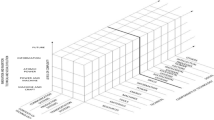Abstract
Technological literacy defines a competitive vision for technology education. Working together with competitive supremacy, technological literacy shapes the actions of technology educators. Rationalised by the dictates of industry, technological literacy was constructed as a product of the marketplace. There are many models that visualise different dimensions of technological literacy, but clear empirical evidence on how these interact is still lacking. A measurement method that comprehensively evaluates technological literacy is missing. Insights into the stem structure and interaction of technological literacy dimensions could be useful for technology education curriculum design and its implementation. In this study, the multifaceted nature of technological literacy was measured using a new assessment method, and dimensions of secondary school students’ technological literacy were empirically investigated. A total of 403 students participated in the quasi-experimental research design. The treatment group consisted of 121 students taught optional subjects relating to technology education. The control group consisted of 282 students. Results from variance analysis showed that optional technology subjects enhance technological literacy, especially students’ technological capacity where a large effect size (η 2 = 0.14) was noted. Results from a path analysis revealed critical thinking and decision-making as the most important dimensions of technological literacy while the predictor of active participation in out-of-school technical activities and technology homework was a key independent influencing factor. A large effect size (R 2 = 0.4) for career path orientation predictors was detected. Technological capacity was revealed as a decisive predictor for a career path in vocational education and technical high school.


Similar content being viewed by others
References
Arciszewski, T. (2016). Inventive engineering: Knowledge and skills for creative engineers. Boca Raton, London, New York, NY: CRC Press, Taylor & Francis Group.
Asunda, P. A., & Hill, B. R. (2007). Critical features of engineering design in technology education. Journal of Industrial Technology Education, 44(1), 25–48.
Avsec, S. (2012). Metoda merjenja tehnološke pismenosti učencev 9. razreda osnovne šole. Ljubljana: Univerza v Ljubljani. Retrived from http://pefprints.pef.uni-lj.si/663/.
Avsec, S., & Jamšek, J. (2016). Technological literacy for students aged 6–18: A new method for holistic measuring of knowledge, capabilities, critical thinking and decision-making. International Journal of Technology and Design Education, 26(1), 43–60. doi:10.1007/s10798-015-9299-y.
Avsec, S., & Szewczyk-Zakrzewska, A. (2015). Predicting academic success and technological literacy in secondary education: a learning styles perspective. International Journal of Technology and Design Education,. doi:10.1007/s10798-015-9344-x.
Benson, C. (2012). The developemnt of quality design and technlogy in english primary schools: issues and solutions. In T. Ginner, J. Hallström, & M. Hulten (Eds.), Technology education in the 21st century, the PATT26 conference. Stockholm, Linkoping: Linkoping Universty, CETIS.
Blest, D. C. (2003). A new measure of kurtosis adjusted for skewness. Australian and New Zealand Journal of Statistics, 45, 175–179.
Blunch, N. (2013). Introduction to structural equation modeling using SPSS and Amos. London: Sage Publications Ltd.
Bordens, K. S., & Abbott, B. B. (2011). Research design and methods: A process approach. New York, NY: McGraw-Hill.
Bryman, A., & Cramer, D. (2011). Quantitative data analysis with SPSS 17, 18 and 19. A guide for social scientists. East Sussex: Routledge.
Castillo, M. (2010). Technological literacy: Designing and testing an instrument to measure eighth-grade achievement in technology education. Paper presented at the meeting of the American Society for Engineering Education, Louisville, KY: Chapman and Hall/CRC.
Childress, V. W., & Rhodes, C. (2008). Engineering outcomes for grades 9–12. The Technology Teacher, 67(7), 5–12.
Cohen, J., Cohen, P., West, S. G., & Aiken, L. S. (2003). Applied multiple regression/correlation analysis for the behavioral sciences (3rd ed.). Mahwah, NJ: L. Erlbaum.
Cox, N. J. (2010). Speaking stata: The limits of sample skewness and kurtosis. The Stata Journal, 10(3), 482–495.
David, H. A., & Nagaraja, H. N. (2003). Order statistics. Hoboken, NJ: Wiley.
De Miranda, M. A. (2004). The grounding of a discipline: Cognition and instruction in technology education. International Journal of Technology and Design Education, 14, 61–77.
de Vries, M. J. (2006). Technological knowledge and artefacts: An analytical view. In J. R. Dakers (Ed.), Defining technological literacy: Towards an epistemological framework (pp. 17–30). New York, NY: Palgrave Macmillan.
Eisenkraft, A. (2010). Retrospective analysis of technological literacy of K-12 students in the USA. International Journal of Technology and Design Education, 20, 277–303.
Eng, J. (2003). Sample size estimation: How many individuals should be studied? Radiology, 227, 309–313.
Field, A. P. (2013). Discovering statistics using IBM SPSS statistics (4th ed.). London: Sage.
Frank, M. (2005). A systems approach for developing technological literacy. Journal of Technology Education, 17(1), 19–34.
Gagel, W. C. (2004). Technology profile: An assessment strategy for technological literacy. The Journal of Technology Studies, 30(4), 38–44.
Garmire, E., & Pearson, G. (Eds.). (2006). Tech tally: Approaches to assessing technological literacy. Washington, DC: National Academies Press.
Gilchrist, W. G. (2000). Statistical modelling with quantile functions. Boca Raton, FL: Chapman and Hall/CRC Press.
Gliner, J. A., & Morgan, G. A. (2000). Research methods in applied settings: An integrated approach to design and analysis. Mahwah, NJ: Erlbaum.
Hayes, S. C. (2002). Acceptance, mindfulness, and science. American Psychological Association, D12, 101–105.
Heppner, P. P., Heppner, M. J., Lee, D., Wang, Y., Park, H., & Wang, L. (2006). Development and validation of a collectivist coping style inventory. Journal of Counselling Psychology, 53(1), 107–125.
Hilton, J. K. (2006). The effect of technology on student science achievement. In E. Alkhalifa (Ed.), Cognitively informed systems: Utilizing practical approaches to enrich information presentation and transfer, pp. 312–333.
Holland, S. (2004). Attitudes toward technology and development of technological literacy of gifted and talented elementary school students. (Electronic Thesis or Dissertation). Accessed 20 June 2016 from https://etd.ohiolink.edu/.
Holmes-Smith, P., Coote, L., & Cunningham, E. (2005). Structural equation modeling: From the fundamentals to advanced topics. Melbourne: School Research, Evaluation and Measurement Services.
Hosking, J. R. M. (2006). On the characterization of distributions by their L-moments. Journal of Statistical Planning and Inference, 136, 193–198.
Ingerman, A., & Collier-Reed, B. (2011). Technological literacy reconsidered: A model for enactment. International Journal for Technology and Design Education, 21, 137–148.
International Technology Education Association/International Technology and Engineering Educators Association. (2007). Standards for technological literacy: Content for the study of technology (3rd ed.). Reston, VA: Author.
Kaiser, H. (1974). An index of factorial simplicity. Psychometrika, 39(1), 31–36.
Kelley, T. R. (2008). Cognitive processes of students participating in engineering. Journal of Technology Education, 19, 50–64.
Kelley, T. R., & Wicklein, R. C. (2009). Examination of assessment practices for engineering design projects in secondary education. Journal of Industrial Teacher Education, 46(2), 6–25.
Klapwijk, R., & Rommes, E. (2009). Career orientation of secondary school students (m/f) in the Netherlands. International Journal of Technology and Design Education, 19, 403–418.
Krathwohl, D. R. (2002). A revision of Bloom’s taxonomy: An overview. Theory into Practice, 41, 213–217.
Kubiszyn, T., & Borich, G. D. (2013). Educational testing and measurement: Classroom application and practise. Hoboken, NJ: Willey.
Lewis, T. (2005). Coming to terms with engineering design as content. Journal of Technology Education, 16(2), 37–54.
Luckay, M. B., & Collier-Reed, B. I. (2014). An instrument to determine the technological literacy levels of upper secondary school students. International Journal of Technology and Design Education, 24(3), 261–273.
Lutz, S., & Huitt, W. (2004). Connecting cognitive development and constructivism: Implications from theory for instruction and assessment. Constructivism in the Human Sciences, 9(1), 67–90.
Mawson, B. (2006). Factors affecting learning in technology in the early years at school. International Journal of Technolgy and Design Education, 17, 253–269.
McMillan, J. H., & Schumacher, S. (2001). Research in education: A conceptual introduction. Boston, MA: Allyn and Bacon.
Moore, G., Raucent, B., Hernandez, A., Bourret, B., & Marre, D. (2005). What can teachers learn from what students say about PBL? In E. de Graaff, G. Saunders-Smits, & M. Nieweg (Eds.), Research and practice of active learning in engineering education (pp. 19–26). Amsterdam, NL: Amsterdam University Press.
Odom, L. R., & Morrow, J. R. (2006). What’s this r? A correlational approach to explaining validity, reliability and objectivity coefficients. Measurement in Physical Education and Exercise Science, 10(2), 137–145.
Petrina, S. (2007). Advanced teaching methods for the technology classroom. Hershey: Information Science Publishing.
Petrina, S., Feng, F., & Kim, J. (2007). Researching cognition and technology: How we learn across the lifespan. International Journal of Technology and Design Education, 18, 375–396.
Rohaan, E. J., Taconis, R., & Jochems, W. M. G. (2010). Analysing teacher knowledge for technology education in primary schools. International Journal of Technology and Design Education,. doi:10.1007/s10798-010-9147-z.
Schermelleh-Engel, K., Moosbrugger, H., & Müller, H. (2003). Evaluating the fit of structural equation models: Tests of significance and descriptive goodness-of-fit measures. Methods of Psychological Research Online, 8(2), 23–74.
Schunk, D. H. (2009). Learning theories: An educational perspective. New Jersey: Pearson Int. Press.
Schunn, C. D., & Silk, E. M. (2011). Learning theories for engineering and technology education. Fostering Human Development Through Engineering and Technology Education, International Technology Education Studies, 6, 3–18.
Shadish, W. S., Cook, T. C., & Campbell, D. T. (2002). Experimental and quasi-experimental designs for generalized causal inference. Boston, MA: Houghton Mifflin Co.
Shumway, S. L., Saunders, W., Stewardson, G., & Reeve, E. (2001). A comparison of cooperative–cooperative and cooperative-competitive goal structures and their effect on group problem-solving performance and student attitudes toward their learning environment. Journal of Industrial Teacher Education, 38(3), 6–24.
Stevens, J. (2009). Applied multivariate statistics for the social sciences (5th ed.). New York, NJ: Routledge, Taylor and Francis Group.
Szewczyk-Zakrzewska, A., & Avsec, S. (2016). Predicting academic success and creative ability in freshman chemical engineering students: a learning styles perspective. International Journal of Engineering Education, 32(2A), 682–694.
Taylor, J. S. (2006). Student perceptions of selected technology student association activities. Journal of Technology Education, 17(2), 56–71.
Thorsteinsson, G., & Olafsson, B. (2015). Piloting technological understanding and reasoning in Icelandic schools. International Journal of Technology and Design Education,. doi:10.1007/s10798-015-9301-8.
Virtanen, S., Raikkonen, E., & Ikonen, P. (2015). Gender-based motivational differences in technology education. International Journal of Technology and Design Education, 25, 197–211. doi:10.1007/s10798-014-9278-8.
Weir, J. P. (2005). Quantifying test–retest reliability using the intraclass correlation coefficient. Journal of Strength and Conditioning Research, 19(1), 231–240.
Wells, J. G. (2016). Efficacy of the technological/engineering design approach: Imposed cognitive demands within design-based biotechnology instruction. Journal of Technology Education, 27(2), 4–20.
Wells, J. G., Lammi, M., Gero, J., Grubbs, M. E., Paretti, M., & Williams, C. (2016). Characterizing design cognition of high school students: Initial analyses comparing those with and without pre-engineering experiences. Journal of Technology Education, 27(2), 78–91.
Whitley, E., & Ball, J. (2002). Statistics review 4: Sample size calculations. Critical Care, 6(4), 335–341.
Wicklein, R. C. (2006). Five good reasons for engineering as the focus for technology education. The Technology Teacher, 65(7), 25–29.
Author information
Authors and Affiliations
Corresponding author
Rights and permissions
About this article
Cite this article
Avsec, S., Jamšek, J. A path model of factors affecting secondary school students’ technological literacy. Int J Technol Des Educ 28, 145–168 (2018). https://doi.org/10.1007/s10798-016-9382-z
Accepted:
Published:
Issue Date:
DOI: https://doi.org/10.1007/s10798-016-9382-z




